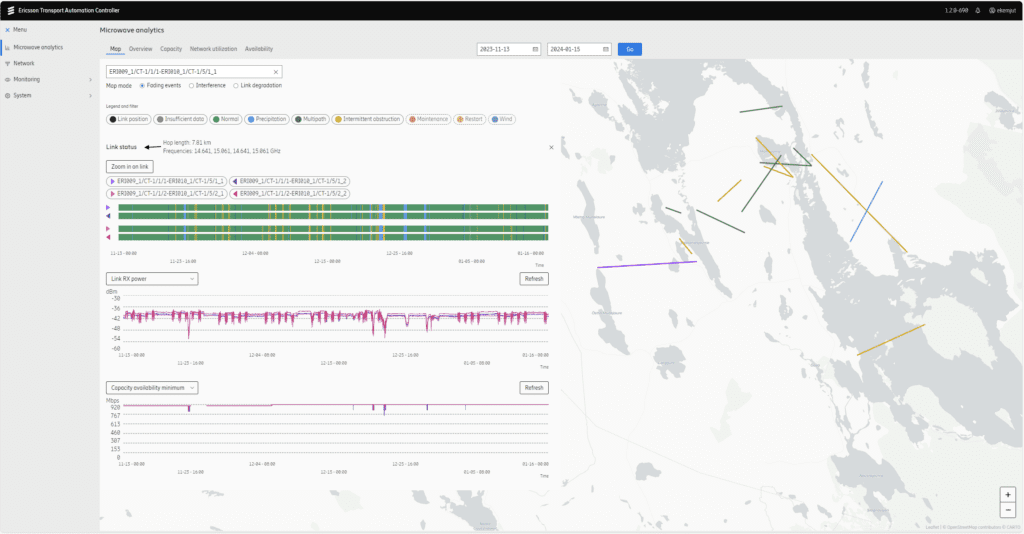What if you could see everything happening in the network? Ericsson is enhancing data visibility for transport automation
As communications service providers (CSPs) navigate the transition to 5G Standalone and the larger shift to cloud-native networks and operations, they are actively investing in the technology needed for increasing levels of network automation. In fact, a sampling of market research data suggests automation investments will grow by around 20% CAGR through the end of the decade. The goal is twofold: in the short-term network automation can increase network and operational efficiency when cash flow is critical and, in the long-term, it’s the only viable option for managing the complexity of networks in the 5G era and beyond.
At a high-level, CSPs today have deployed 5G with a focus on enhanced mobile broadband; the next evolution of 5G will be marked by layering in support for massive internet of things implementations, ultra-reliable low latency communications, and network configurations tailored for the demands of specific vertical industries such as logistics and manufacturing. This also comes with a larger shift to a cloud-native architecture that includes upgrades to the core infrastructure, a more distributed approach to the radio access network, and corresponding adjustments to transport.
Complexity across these domains continues to increase, which means that visibility of network performance and a solid understanding of the network status become more challenging due to a range of factors, including increasing capacity demand, the need to manage modern and legacy infrastructure, the proliferation of multi-vendor systems, and the need to maintain a future-ready posture as 5G Advanced and 6G take shape.
As challenges to visibility mount, CSPs could see issues around root cause identification, a spike in site visits, configuration errors and balancing domain-specific optimizations with the need for end-to-end system performance—all things that can drive up costs. This highlights the significance of network automation to boost reliability and consistency, facilitate advanced services and accompanying new business models, and enhance security. In the context of an end- to-end network automation strategy, the importance of visibility and understanding of the network status and performance data can’t be overstated as it provides the input for intelligent decision making.
Imagine you could see everything happening in the vital transport network in real time via a single pane of glass? With Ericsson Transport Automation Controller, Ericsson is working to answer that question with a resounding ‘Yes,” – with the use of artificial intelligence and machine learning-based predictive analytics that automatically identify and resolve problems, and optimize the use of network resources.
Observe, analyze, act with the Ericsson Transport Automation Controller
“It’s not a secret that automation is increasingly important in the telecommunications industry. And for valid reasons,” Ericsson’s Jari Augustin, Head of Product Line for Transport Automation, told RCR Wireless News in an interview. Referencing increasing capacity demands and exponential growth in network-connected devices, he said, “It’s humanly impossible to manage the complexity in all these network changes at scale with quality and speed.”
This (again) makes the case for network automation, but before a CSP can automate a network process, it has to have visibility into the network process. “CSPs are in the dark when it comes to understanding the network state,” Augustin said. “And when you do not see, it’s hard to know what to do.”
Ericsson’s approach to solving this visibility problem in the transport domain boils down to better observation of network behavior and performance, frequent data collection, real-time analysis of that data, and turning that data insight into an automated action, enabling CSPs to run the transport network proactively and efficiently. That’s essentially the thesis statement for the Ericsson Transport Automation Controller.

With more robust visibility and observability, Augustin said, “The idea is that service providers can focus on fixing issues, not troubleshooting. You will find the needle in the haystack.” Deep AI/ML-based analysis will determine the root cause of an issue then predict future problems based on a growing pool of network data. That important distinction between raw data and raw data translated into actionable insight is what literally and figuratively closes the loop, allowing the controller to automate operations for things like service provisioning and traffic steering, energy-saving configuration and monitoring. “This doesn’t only improve time to market, but also reduces human error and misconfigurations, which are still some of the prime reasons for networking issues,” he said.
Expanding on the importance of visibility and automation to ensure end-to-end optimization of network resources and functions, Ericsson’s Strategic Product Manager for Transport Automation Jutta Kemppainen described a “customer journey” wherein you can start with basic automation then progress in phases. “It’s important to know where you are so you can identify the right next steps and adjust accordingly. Having the right visibility is the base to start from and then build upon until you reach this self-healing, super intelligent, fully-automated network.”
Click here to read more about how 5G transport automation can help reduce network opex

